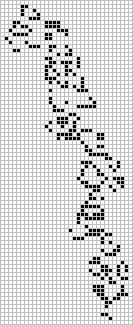Types of spaceships
There are many different types of spaceships in Conway's Game of Life and related automata. The following are the terminology that are in common use. This page contains only very general terminology that applies to wide varieties of spaceships.
Universal classifications
Classifications that apply to both elementary and engineered (see below) spaceships.
Flipper
| It has been suggested that this article or section be merged into Kinetic symmetry. (Discuss) |
A flipper is a spaceship (or oscillator) that forms its mirror image halfway through its period. All flipper spaceships are glide symmetric and conversely all glide symmetric spaceships are flippers. All of the functional standard spaceships are flippers.
Glide symmetric spaceship
- See also category Glide symmetric spaceships
| It has been suggested that this article or section be merged into Kinetic symmetry. (Discuss) |
A spaceship is said to be glide symmetric if it undergoes reflection and translation simultaneously. It is not difficult to show that a spaceship is glide symmetric if and only if it is a flipper.
Non-monotonic spaceship
- See also category Non-monotonic spaceships
A spaceship is said to be non-monotonic if its leading edge falls back in some generations - i.e., the frontmost row doesn't always move forward or stay where it is. The first non-monotonic spaceship to be found was the diagonal 13-engine Cordership, by Dean Hickerson in April 1991. The first orthogonal example was found by Hartmut Holzwart in August 1992, which has period 4 and travels at speed c/4. In April 1994, Holzwart found examples of period-3 spaceships with this property, and this is clearly the smallest possible period. Another well-known non-monotonic spaceship is the weekender. Bulldozer's front part is non-monotonic, and so is the whole ship (unless its corresponding pushalong is introduced).
Oblique spaceship
- Main article: Oblique spaceship
An oblique spaceship is a spaceship that moves neither orthogonally nor diagonally. Knightships (infra) are the simplest example of oblique spaceships; others include Andrew J. Wade's ibisship Gemini, and Brett Berger's Waterbear, with a displacement of (23,5) every 79 generations.
Knightship
- Main article: Knightship
A knightship is a spaceship of type (2m,m)/n (that is, a spaceship that moves two cells horizontally for every one cell it moves vertically).
Various large knightships have been constructed since 2010; the first truly elementary knightship, Sir Robin, was found by Adam P. Goucher on March 6, 2018, based on a partial by Tomas Rokicki.
Elementary classifications
Classifications that only apply to elementary spaceships.
Standard spaceship
A standard spaceship is a glider, lightweight spaceship, middleweight spaceship, or heavyweight spaceship. That is, it is one of the original spaceships that have been known since 1970. Many failed standard spaceships like the overweight spaceship and the B-heptomino as well as the hassled object in the roteightor also display standard-like behavior and can be hassled. Nontrivial flotillae of interacting elementary spaceships do not count as standard spaceships. A non-standard spaceship is any other spaceship.
Edge-repair spaceship
An edge-repair spaceship is a spaceship that has an edge that possesses no spark and yet is able to perturb things because of its ability to repair certain types of damage to itself. The most useful example is edge-repair spaceship 1, which can destroy Herschels as it travels. Another well-known example is edge-repair spaceship 2, which can destroy beehives.
Flotilla
A flotilla is a spaceship composed of a number of smaller interacting spaceships. Often one or more of these is not a true spaceship and could not survive without the support of the others. Flotilla 1 is the most common example, and it contains an overweight spaceship escorted by two heavyweight spaceships.
Frothing spaceship
A frothing spaceship is a spaceship whose back end appears to be unstable and breaking apart, but which nonetheless survives (compare with frothing puffer). The exhaust festers and clings to the back of the spaceship before breaking off.
Smoking ship
- See also category Smoking ships
A smoking ship (or smoky ship) is a spaceship that produces smoke. If the smoke extends past the edge of the rest of the spaceship, then it can be used to perturb other objects as the spaceship passes by. Running gliders into the smoke is often a good way to turn or duplicate them, or convert them into other objects. Sometimes the smoke from a smoking ship may itself be perturbed by accompanying spaceships in order to form a puffer. Simple examples of a smoking ship are Schick engine, Ecologist, Pufferfish spaceship and Coe ship. Sometimes combinations of smoking tagalongs are puffers - such as a p48 blinker puffer produced by attaching two Coe engines to LWSS's pulling the Schick engine.
Spaceship made of spaceships
A spaceship made of spaceships (SMOS) is a spaceship consisting of multiple other spaceships colliding with one another and eventually regenerating themselves in a different position.
Engineered classifications
Classifications that apply only to engineered and adjustable spaceships.
Self-constructing spaceship
Geminoid
A Geminoid is any self-constructing spaceship formed by boustrophedonically (i.e. alternating lines in opposite directions) shuttling one or more construction tapes between two universal constructors. Examples include Demonoids and Orthogonoids.
Geminoid is named after Gemini, the first oblique spaceship to be constructed. It uses twin universal constructor mechanisms sharing a single construction recipe in the form of long streams of gliders. Each universal constructor builds a copy of itself at a fixed offset, while simultaneously disassembling the previous copy of itself and reflecting the construction recipe 180 degrees to feed into the new copy of its twin.
Loopship
A loopship is any self-constructing spaceship that travels by repeatedly creating a signal storage loop that is large enough to hold a complete representation of the construction recipe for that same memory storage loop. Examples include orthogonal loopship, speed orthogonal loopship, and self-synthesizing oblique loopship.
See also
External links
- Introduction at the Life Lexicon
- The off-slope gliders at David Eppstein's Glider Database
